Ayrshire Resilience Scheme: Phase 2 Highlees (2018)
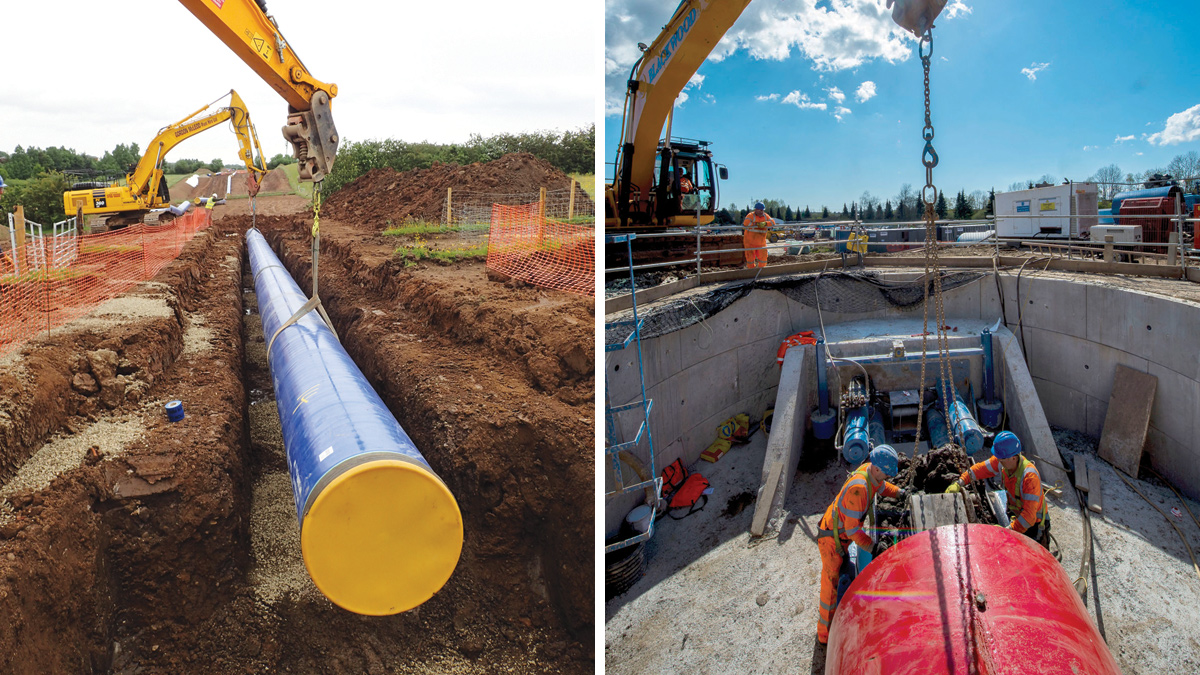
(left) Pipeline installation - Courtesy of Caledonia Water Alliance, and (right) TBM installation earth removal - Courtesy of SW/SNS Photography
During investment period 2016/17, Scottish Water commenced the first phase of construction on a £120m investment project known as the Ayrshire Resilience Scheme, designed to improve the resilience of the drinking water network throughout much of Ayrshire and parts of East Renfrewshire. Once complete, this scheme will benefit more than 200,000 Scottish Water customers. Caledonia Water Alliance (CWA), working in partnership with Scottish Water, developed the initial design concepts for the Ayrshire Resilience Scheme ready to progress to the self-delivered construction phase for Phase 1 Amlaird and Phase 2 Highlees. Phase 1 is now complete and Phase 2, which commenced in October 2016, is well underway on site.
Background
Scottish Water highlighted the need to provide resilience of water supplies to the Ayrshire section of their clean water network and the agreed solution devised was to construct a new large diameter pipeline, supplied by an existing water treatment works (WTW) to the north of Glasgow and connect it into the water network near Kilmarnock, Ayrshire.
This was then developed into a bi-directional resilience project with the addition of a pumping station that will be capable of transferring water between Ayrshire and the south of Glasgow.
Pipeline design and construction
The Phase 2 Highlees element of Ayrshire Resilience Scheme involves construction of a 21km pipeline from a WTW close to Dundonald to a distribution service reservoir (DSR) near Kilmarnock, constructed using 900mm diameter spiral welded steel. The completed 21km water main is designed to transfer flows of 50Ml/d and is capable of operating bi-directionally; with capability to support Ayrshire by pumping from DSRs in the south of Glasgow or to support Glasgow by pumping from the Kilmarnock area back to the DSRs. The project includes the construction of a new 50Ml/d capacity pumping station.
The engineering design principles of Phase 2 were wholly compatible with those of Phase 1. Determination of the most hydraulically advantageous route for pipe-laying works in addition to defining an apposite option for the pipeline, taking account of passing through private land and crossing beneath major trunk roads, watercourses and live railway lines. For the project team, the design and construction of this pipeline was challenging in terms of ascertaining the optimum route whilst balancing sensitive constraints, landowner and stakeholder concerns, including consultation with the seven local Community Councils.
Pipeline selection and delivery
Continuity with Phase 1 was maintained utilising welded steel pipe. The 900mm diameter spiral wound steel pipes were externally coated with medium density polyethylene (MDPE) and internally lined with an epoxy resin.
The pipes were sourced via FT Pipeline Systems Ltd from specialist steel pipeline manufacturer, Erciyas, in Turkey. The logistics of getting the 13m long sections of pipework from Turkey was a feat in itself; considering each pipe section weighs approximately 3T. The pipes were delivered via two cargo vessels; progress of their journey was tracked via the Marine Traffic Website to Glasgow’s King George V Dock. The pipes were inspected at the dock-side prior to transportation by truck, four pipe sections at a time, directly to site and, where possible, strung out along the working strip.
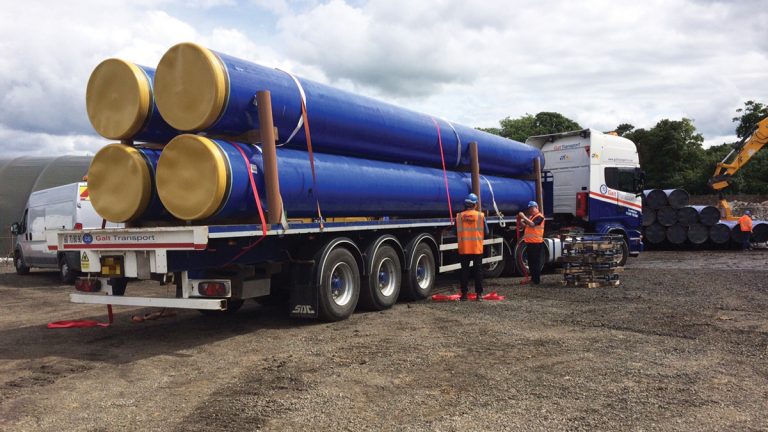
Pipes to be offloaded at site – Courtesy of Caledonia Water Alliance
Where appropriate, pipes were welded together three at a time, before being lowered into the trench. The ‘fourth weld’ effectively joining two sets of pipe strings together was undertaken directly in the trench. The jointing method was by E-joint, which is specially designed to avoid heat damage to the internal epoxy lining.
Pipeline construction
The planned route involved four major crossings (two roads, one railway line and one river crossing), which required the construction of tunnels as well as two auger bore drives. Three 1,500mm diameter tunnels have been completed beneath the A77, A76 and River Irvine, respectively; totalling 240m in length.
To achieve this, six segmental lined shafts (each an average of 8m in diameter) were required to be excavated in ground conditions ranging from stiff clay to solid rock. A further two shafts were excavated on the outskirts of Kilmarnock, and a 132m tunnel has now been driven below an existing railway line. A 9m-long hydraulically-operated tunnel boring machine (TBM) excavated tonnes of earth prior to installing a series of precast concrete pipes, each weighing almost 5T, to create the tunnels.
Excavation works alone for the tunnel under the railway amounted to around 2,500T of displaced earth, followed by a further 1,260T of earth displaced during the tunnel drives; resulting in a total amount in excess of 3,700T of earth was moved to create a single tunnel crossing.
Furthermore, pipe-jacking activities were carried out beneath the A71 and B7036, respectively. By taking this approach, CWA was able to mitigate traffic disruption at both these busy thoroughfares and one of these crossings. Notably, this approach avoided the need for two watercourse crossings.
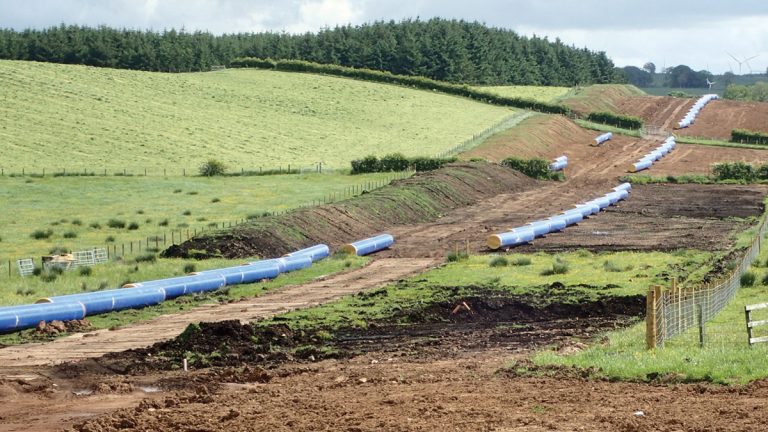
Pipes laid out awaiting welding – Courtesy of Caledonia Water Alliance
New pumping station
In addition to the installation of spiral welded steel pipework, there was the requirement for a new 50Ml/d pumping station. The pumping station structure was designed in consultation with the Local Authority’s Planning Department to ensure the new structure would have minimal environmental and/or visual impact.
Under CWA’s self-delivery model, teams were mobilised to progress construction of the pumping station supported with the intricate mechanical and electrical elements by appointed specialist sub-contractors. The pumping station works comprised:
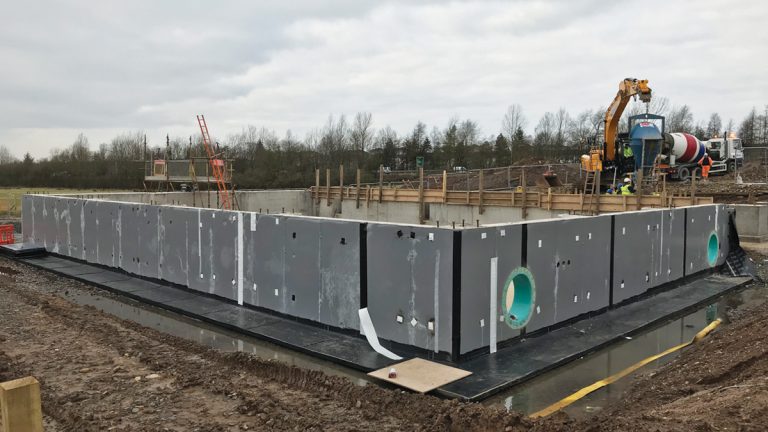
Pumping Station structure under construction – Courtesy of CWA
- Formation of a base slab.
- Installation of connection pipework for the two pumps (duty and assist).
- Two parallel pressure reducing valve arrangements along with bypass pipework.
The base slab was cast in December 2017, requiring 360m3 of concrete and was poured just one day ahead of the planned site closure for the festive break. Work is well underway on the rest of the pumping station superstructure, with cladding and the roof now in place and mechanical and electrical installation works are well under way with a planned completion date of late August to allow commissioning to start in September. These works have been recorded using a pole-mounted time lapse camera and the images will be combined with the 3D AutoCAD model to produce a video of the construction from green field to green shed.
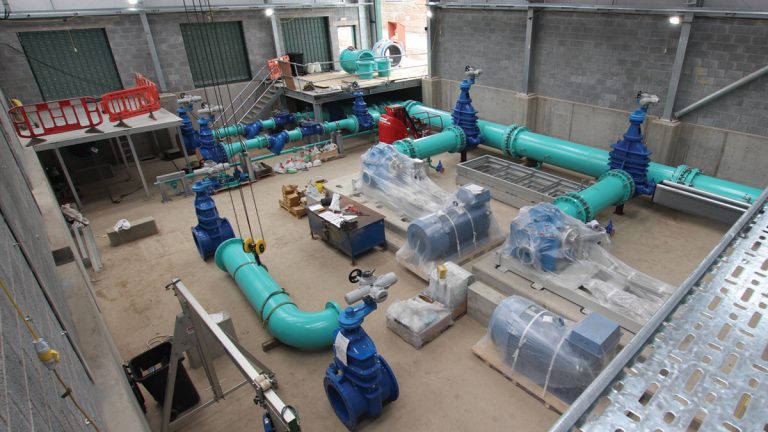
Pumping station fit out – Courtesy of Caledonia Water Alliance
Engineering constraints and challenges
During the design stage and pre-construction phase works, a suite of desktop risk assessments and site walkovers were undertaken, identifying a variety of engineering challenges potentially affecting the planned pipeline route. These include proximity to trunk roads, live railway lines, overhead power cables, existing high pressure gas mains and various other utility services; all of which need to be overcome. At a select number of points along the planned pipeline route, there was a requirement for works to be undertaken directly below live overhead power lines and crossing high pressure gas mains; Scottish Power Networks and Scottish Gas Networks were consulted to agree safe working practices.
Minor road crossings were undertaken by adopting an open cut technique, setting up weekend road closures in consultation with both the local community and Roads Authority.
The most significant challenges with the design and construction of the pipeline were posed by the multiple crossings (road, railway line and watercourse). The design incorporated trenchless crossing techniques by tunnel boring methods. Ground investigation data was critical to the design of the tunnelled sections and in particular, those beneath the A77 trunk road and railway line crossings. Well documented designs were developed, which were reviewed and ultimately approved by third party consultants as appointed by Transport Scotland and Network Rail, respectively.
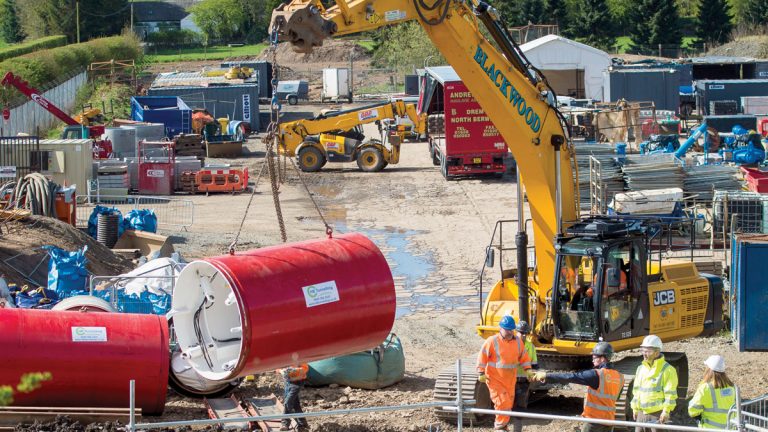
TBM installation lift – SW/SNS Photography
Environmental constraints and challenges
Constraints identified as part of site walkover survey and initial ground investigation works include the existing ground conditions, and in particular the presence of deep peat (up to 5m below ground level) in some areas.
As part of the pre-construction works, the site investigation contract was completed by Environmental Scientifics Group Ltd, (ESG), in April 2017. A LiDAR survey was also completed via a drone survey, with the data obtained utilised to build a detailed design model and hydraulic profile of the overall project.
Environmental issues were also identified, which have had an impact, albeit indirectly, on the construction phase. Environmental considerations in this region are paramount; therefore any planned activities were carried out with the utmost care, sensitivity and attention.
There are concerns over the proximity of an ancient woodland to the construction works. A select number of trees had to be removed to allow installation of the pipeline hence a specialist arborist was appointed to determine which trees could be taken down and the safest way to do so.
Linked to the tree removal, a specialist monitoring of identified trees was implemented to check for any presence of nesting birds during the nesting season (March to July). If nesting birds were discovered, tree removal would be halted until the end of the nesting season.
In the vicinity of the construction area known salmonid watercourses flow near the planned pipeline route, therefore construction works activities were assessed for potential risks posed to watercourses.
To minimise the risk of silt pollution, silt traps were constructed to intercept any surface runoff prior to entering the watercourses.
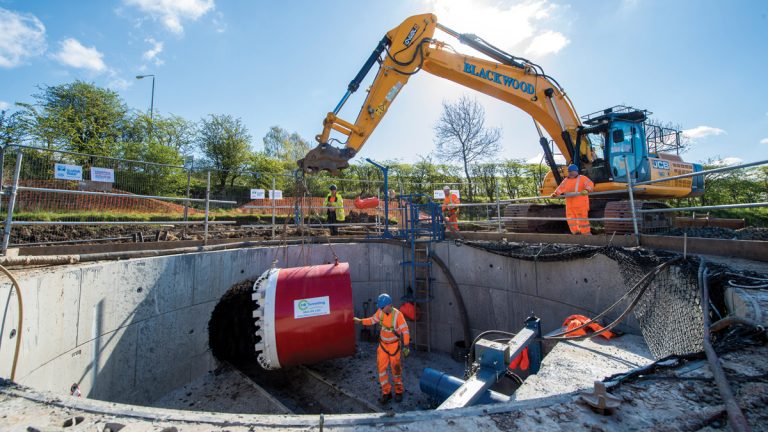
TBM installation positioning – Courtesy of SW/SNS Photography
Craufurdland Water
Pipe installation below the Craufurdland Water was successfully completed via an open cut method; to enable this, a temporary diversion of the substantial river flowing through East Ayrshire was required to allow works to progress.
This was a major undertaking for CWA and was efficaciously delivered thanks to the close liaison with both Scottish Environment Protection Agency (SEPA) and Ayrshire Rivers Trust. As a direct result of the consultations with these stakeholders, Ayrshire Rivers Trust worked with CWA to rescue in excess of 300 fish, including salmonids, loach and minnows over a period of two days ahead of the planned river diversion works. This river diversion and fish rescue was somewhat of a first for CWA.
Historically significant archaeological finds
A key constraint arose during the construction phase with the identification of archaeological finds of significant historical importance, found during top soil stripping activities along the pipeline route in countryside near Kilmarnock. Scottish Water employed an archaeologist on a watching brief, who identified six areas of interest along the planned pipeline route.
Archaeologists from appointed subcontractor, GUARD Archaeology Ltd. (GUARD) unearthed an incredibly exciting archaeological find – the remains of a prehistoric dwelling from the Neolithic period (3,500BC-4,000BC), meaning the dwelling was occupied approximately 6,000 years ago.
The discovery of the remains of a number of post-holes which formed part of an early Neolithic structure is believed to predate both the Callanish Stones in Lewis and Stonehenge in Wiltshire. The post-holes outlined the boundary of a rectilinear hall measuring 14m long by 8m wide; with this type of dwelling relating to those built by Scotland’s first farming communities. Also discovered were fragments of a Neolithic Carinated Bowl, used for cooking and storage. The find will add significantly to the knowledge of the history of this area.
Following the discoveries, the unearthed items were removed from CWA’s site for detailed recording and analysis. As with all archaeological finds in Scotland, the artefacts will be claimed by The Crown and deposited in keeping with Scottish legal requirements as set out in the Scottish Government’s Treasure Trove Code of Practice. In accordance with CWA and Scottish Water policies and procedures works were suspended in the areas affected until the archaeologists completed their work, with the programme altered accordingly to minimise the impact on progress.
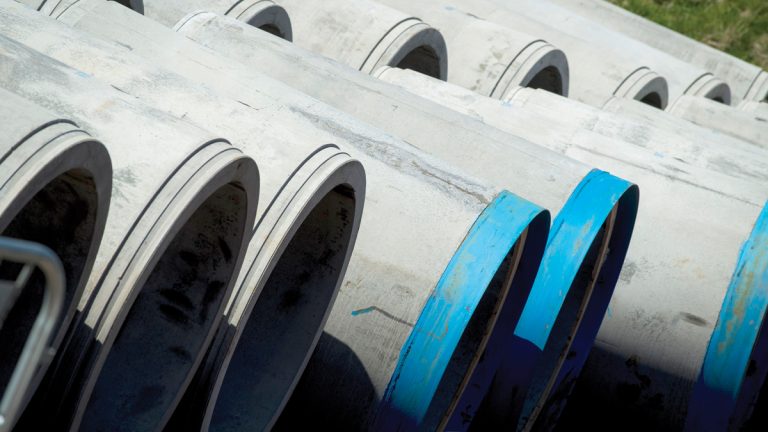
Concrete tunnel pipe sections – Courtesy of SW/SNS Photography
Communication is key
CWA’s Customer Care and Scottish Water’s land liaison teams invested time and tremendous effort with customer and stakeholder liaison. The teams met with local Community Councils and explained the proposals, forewarning of activities and what measures would be put in place to minimise the impact.
Meetings with landowners, land agents and other stakeholders were held regularly to ensure continuity of communications related to the project and progress updates leading up to and during the construction phase. The teams worked to resolve issues during both the design and construction phases of the project.
Scottish Water agreed compensation through negotiation with landowners and land agents, and Scottish Water’s legal team handled the land acquisition for the pumping station site.
Through continued communications, CWA’s project and customer care teams aim to address and, where possible, limit the impact of the works on Scottish Water’s customers, while continuing to work to planned timescales and budget.
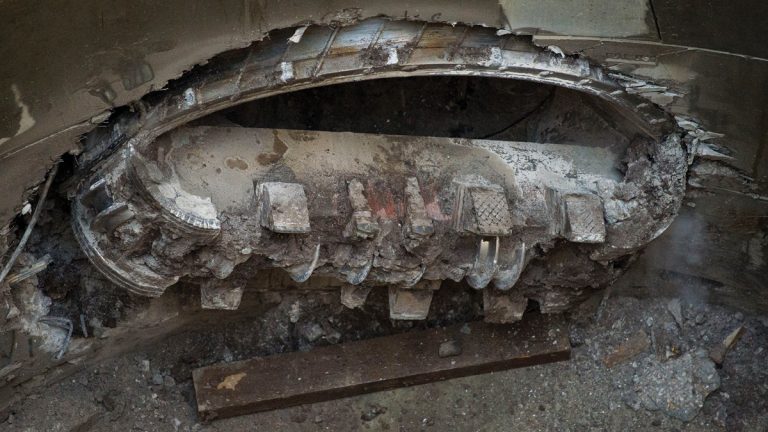
TBM breakthough – Courtesy of SW/SNS Photography
Progress to date
From a construction perspective, progress on the construction of Phase 2 Highlees has continued at pace since CWA commenced works on site back in October 2016; now with all 21km of pipe installed and 95% pressure tested. CWA was keen to take advantage of the longer summer days, deploying four pipe-laying teams working seven days per week to expedite the pipe-laying activities. Additional teams were also drafted in to support the main pipe-laying operation, completing the 21 road crossings in advance to maximise efficiency.
As CWA now enter the final phase of the pipeline construction, the next steps involve the tie-in connection works to the DSR. The new pumping station is currently under construction, with a planned completion date of August 2018 and commissioning completed by December 2018.
All agricultural land will be fully reinstated by the end of August 2018 including extensive land drainage, topsoil replacement, grass seeding and cultivating along with all land boundary fences replaced. CWA are driving an ambitious delivery programme to facilitate early commissioning activities on the new main in late summer/early autumn 2018.
Scottish Water’s Ayrshire Resilience Scheme: Phase 2 Highlees Project is progressing at a fast pace to completion of the construction stage; providing current timescales are adhered to, the project will remain on target for successful delivery as planned in February 2019.







